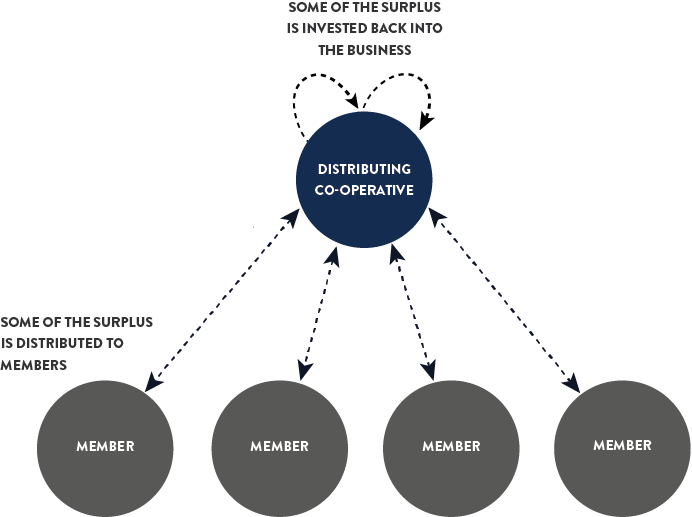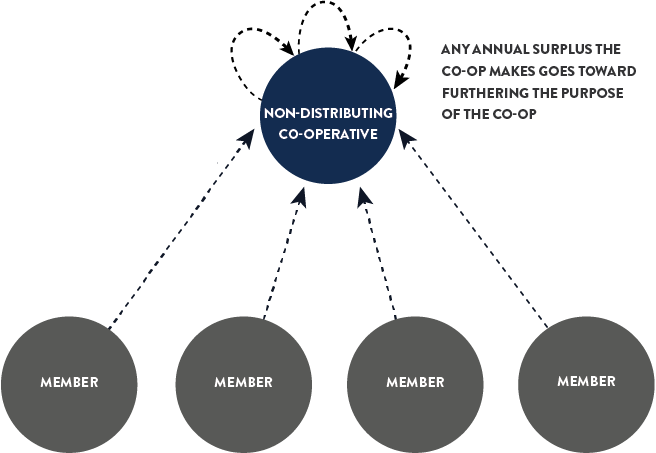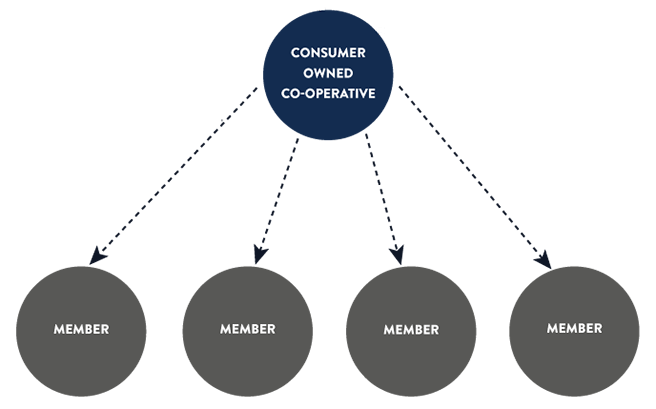What are co-operatives?
Co-operatives are jointly owned, autonomous businesses formed to benefit their members who are also their owners. In a co-op, ownership and control is shared equally amongst members who use the enterprise to meet a common purpose.
The members of a co-op can be individuals, other businesses, employees or community stakeholders.
Co-ops are formed for many social and economic reasons whether it’s to help their members scale or give them better buying power, to facilitate sharing the costs of running a business, to have better jobs and work conditions, to access education or social care services or to pool risk and insure against unforeseen events.
Co-operatives are the only business model with a set of internationally agreed values. The seven co-operative principles keep co-operatives true to their social purpose.

Distributing vs non-distributing
Co-operatives are flexible
Co-ops are flexible business structures encompassing entities with non-profit status or charities, or they can operate for profit.
A distributing co-operative can distribute any and all of its annual profits to active members. This can incentivise members to strive for the co-op’s commercial success. A distributing co-operative must have share capital and members must own the minimum number of shares specified in the co-op rules.

A non-distributing co-operative can’t share profits with members. All profits must further the co-op’s purpose. It does not need to issue any shares to members, but this isn’t prohibited. Non-distributing co-operatives meet the ‘not for profit’ definition for Australian taxation purposes.

Types of co-operatives
Co-operatives have an active membership test which ensures there is a reciprocal relationship between the member and the co-op. Co-ops can have one type of member or be multi-stakeholder.
Members receive or purchase a service like customers banking with a credit union or mutual bank.
A co-operative is a business entity owned and controlled by the people who are its customers. The members of a consumer-owned co-operative purchase quality goods or services from the co-operative at a competitive price.
Consumer-owned co-ops operate in many industries:
- Retail and wholesale co-operatives
- Housing co-operatives
- Health care co-operatives
- Insurance
- Motoring
- Banking and financial co-operatives
The world-wide co-operative movement was founded by a consumer-owned co-op in 1844 – the Rochdale Equitable Pioneers Society. The Rochdale Pioneers were twenty-eight weavers who together set up a retail store based on very similar principles to those later adopted by the International Co-operative Alliance. The store was owned democratically by its customers, who paid market rates for the goods so that the co-operative could generate a surplus. The surplus was used for further investment in the business, for education and co-operative development, and to pay dividends to its members.
The idea took hold, with an average of one retail store opening every week over the next six years. In 1859, only thirteen years after the first Rochdale store opened, a Rochdale-type store opened in Brisbane, with others soon forming in Newcastle and Sydney. There are many similar co-ops operating today in Australia, selling high quality retail products to their members.

The members of a worker co-operative are the employees with a stake in deciding how the business is run.
A worker co-operative is a business entity owned and democratically controlled by the people who work in it – its employees. It allows employees to define working conditions, salaries and benefits, and share in surpluses in proportion to salary earned or hours worked.
Worker co-operatives date back to around the 1850s. Their development in the 20th century was closely tied to Catholic teaching, particularly to the principle of “subsidiarity” contained in the 1891 encyclical Rerum Novarum, set out by Pope Leo XIII in 1891. Subsidiarity is the doctrine that decisions should be decentralised – that a higher body should not assume the functions of a lower body which the lower body is able to perform for itself.
The largest number of worker co-operatives are in Northern Italy and in Basque Spain. In the latter can be found Mondragon Co-operative which employs over 70,000 worker-owners. Australia has only a small number of worker co-ops, though they are significant organisations for their communities.
Some examples of work co-operatives in Australia are Nundah Community Enterprises Co-operative and SGS Economics and Planning.
Listen to part 1 and part 2 of The EO Podcast featuring Graeme Nuttall, OBE discussing employee ownership in the UK and around the world.
Small Business Banter aims to educate and support regional and rural small business owners. Each week Michael Kerr interviews a fellow owner, or other small business adviser or expert. They share their stories, their best tips and their most practical advice.
Listen to Kate Biondo CEO of worker-owner Galactic Co-operative on starting and running their technology business on the Small Business Banter podcast.

Producers sell into the co-op or share supply chain costs as in a farmer owned co-operative.
A producer co-operative is a business entity owned and democratically controlled by producers who band together to process or market their products. An example is an agricultural co-operative, which enables farmer members to process their produce and access markets collectively, giving them better bargaining power and increased prices for their goods. The co-operative is the key market for the members’ products, and is owned by the members who sell or buy its products and services.
Producer co-ops, also called marketing co-ops, have existed for a long time. The first known producer co-operative in Australia was a dairy co-operative in New South Wales founded in 1880: The South Coast and West Camden Co-operative. A problem for farmers at the time were the “middle men”, who combined together informally to drive down returns for farmers at no benefit to consumers. The co-operative worked instead to deliver fair returns to farmers at fair market prices for customers.

Co-ops can be owned by a network of businesses which gives them buying power and scale whilst staying independent.
An enterprise co-op is a business entity owned and controlled by other businesses, often small and medium enterprises like family farms or independent retailers. It enables businesses to band together to find strength in numbers.
An enterprise or purchasing co-operative, is formed to purchase and supply goods and services at competitive conditions in the interest of members, who own and control it equally. An example is a wholesaler for independent retail outlets, which purchases goods in bulk and sells them to members, giving them better bargaining power and lower prices for the goods they need for their business.
Purchasing co-ops, which can also be called wholesale co-operatives, have been formed by plumbers, the automotive industry and others to obtain supplies at lower prices due to the power of group buying. Other services may be available to members, including marketing, finance, training and travel. Wholesale co-operatives include agricultural, grocery, liquor, seafood, travel agents, furniture, hairdressing, toys and newsagents.

Multi-stakeholder co-operatives are co-ops that formally allow for governance by representatives of two or more “stakeholder” groups within the same organisation, including consumers, producers, workers, volunteers or general community supporters.
This can help align the interests of otherwise competing stakeholders – producers and consumers, for example. They are appropriate when there is a need to plan long-term for the needs of various stakeholders and the normal market relationship is leading to inefficient short-term investment horizons.
Having only gained traction in the 1990s, multi-stakeholder co-ops are one of the newest models of co-operative.
Other co-operative types
Co-operatives are flexible entities and respond effectively to new conditions. With businesses moving onto the internet and operating as platforms, a new type of co-operative has come into being – the platform co-op. Think Uber or Amazon, but owned by the drivers and the customers respectively.
The first platform co-op to be registered in Australia is bHive Bendigo, a sharing economy platform owned by its users.
Some of the benefits of platform co-operatives include:
Protection from exploitation through ownership, transparency, control
Unlike Uber and Facebook, which are owned by investors, a platform co-op is owned by its members. An Uber owned by its drivers, or a Facebook owned by its users, would provide ownership, control and protection against exploitation for members.
Prospect of data democracy
Ownership of data is valuable; so much so, data has been called the new oil. A platform co-operative, because it is owned by its users, would remain accountable to them in its use of their data.
Money flows within local communities
Platform co-ops like bHive Bendigo are owned locally, which keeps the profits made by the platform local giving the community an economic boost.
Useful links
Community-owned co-operatives
Community co-operatives are businesses owned by people who live in a particular geographical area. Membership is open to the public. The co-operative can be for-profit, not-for-profit or charitable, but always exists to provide goods and services to its members on an equitable basis.
In order to maintain equity, community-owned co-ops operate on the basis of one member, one vote.
Community buyouts
A community buyout is when a group within the community works together to purchase and manage an existing business or service. This is in contrast to when a community establishes an enterprise to develop a new business or service.
The motivation for a community buyout may be the closure of an essential service: rural and regional communities, in particular, depend on small local businesses, such as the local shop, garage or post office. The closure of these businesses can threaten the viability of these communities, creating a catalyst for the community to come together to purchase and operate the service.
Otherwise, dissatisfaction with how an existing business or service is run may be the motivation for a community group to consider taking ownership.
Community buyouts require the same attention to business planning, community consultation and governance in their development as other business ventures.
Benefits of community ownership
For local retail operation, co-op ownership by the local community means greater community influence over operations and greater incentive for community involvement as customers.
Community-owned co-operatives share any profits equitably with members (for example, dividends on shares, rebates on purchases) and community (for example, sponsorships).
Wealth is retained in the local area, rather than adding to the profits of national or internationally-owned corporates.
Community owned businesses tend to be more sustainable (less likely to fail than traditionally owned businesses) and are able to take a longer-term view as there are no external shareholders requiring short-term returns. Their driving purpose is to maintain the service for members and the community.
When are community-owned co-ops and community buyouts appropriate?
The development of a new community-owned co-op or the community buyout of an existing business both require sufficient community support and organisation. Community members may need to be persuaded that the plan has potential to succeed. Organising a community meeting to share information and explore different options is a good starting point to see whether there is support for the idea.
How to start a community-owned co-op
Once you have a group of interested people in the community, a good first step in starting a community-owned co-operative is establishing a steering group that can refine your business idea and investigate feasibility, and if there is a feasible option, undertake business planning.
This group can keep the wider community informed on progress and seek feedback from the community.
For the next stages on starting a co-operative, see setting up a co-op. The BCCM supports new co-operatives, providing advice, education and referrals. We deliver workshops to help newly-forming co-operatives to understand the potential benefits and the legal requirements of the co-operative structure in more detail.
Resources/further reading
- About co-operatives
- What is a co-op? (International Co-operative Alliance)
- Delivering Employee and Community Buyouts (please note that while this guide is a useful planning tool, it pertains to the UK legal and financial environment and was published in 2003).
For further information or support in exploring a community co-op model, contact the BCCM.
Co-operative legal structures
Co-operatives are incorporated bodies, so members are not liable for the co-operative’s debts. The co-operative it is a limited liability entity. The co-op is a limited legal identity, so it can buy, own or sell property itself.
A co-operative is an incorporated body, with a board of directors who manage the business of the co-operative and are accountable to members.
Co-operatives are defined as democratic organisations controlled by their members, who each have one vote, no matter how many shares they hold. They subscribe to the seven international co-operative principles.
To meet the definition of a co-operative, a group may incorporate under any of the following Australian legislation:
- The Co-operatives National Law
- Every state and territory has adopted Co-operatives National Law (CNL) or legislation consistent with it. CNL is most appropriate because the co-operative principles are baked into the legislation. Under other incorporation acts these principles must be inserted using the co-operative’s constitution, which can be precarious for members.
- Incorporated Associations legislation
- Each state and territory has a different associations act
- Corporations Act 2001 (Cth)
- Corporations (Aboriginal and Torres Strait Islander) Act 2006 (Cth)
- Legal Models Comparison Matrix

